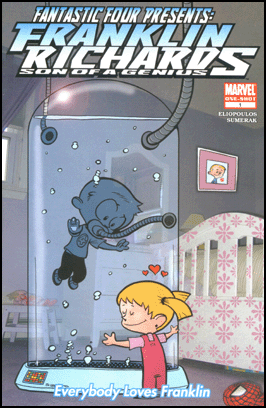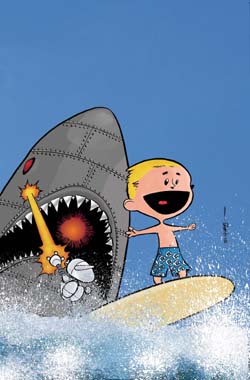- Comics
- Comics Reviews
- Manga
- Comics Reviews
- European Comics
- News
- Comics News
- Press Releases
- Columns
- Spotlight
- Digital Comics
- Webcomics
- Cult Favorite
- Back Issues
- Webcomics
- Movies
- Toys
- Store
- More
- About
By Geoff Hoppe
September 5, 2006 - 12:54
Chris Eliopoulos has made quite a name for himself in the comic book world. He was personally requested to be the letter for Erik Larsen's Savage Dragon, and more recently, is known for his Franklin Richards: Son of a Genius. He was kind enough to speak with me about his education and career--

G: How did you get started in the comic book business?
C: I went to college in
G: That's a pretty amazing introduction! Gene Colan's a legend.
C: Yeah. I wasn't into comics and didn't know who he was. It was only later that I learned to be in awe of him. (smiles)
G: So your internship with Marvel was your first real introduction to comics? You weren't into them as a kid?
C: As a little kid I would read a comic now and then, but it was out of boredom. In High School, I had a friend into them and he tried to get me interested. For a while I was, but nothing major. I'd read some of his books, but it died off--the friendship and the interest. My real love was cartooning and comic strips.

G: Your humor's been compared to Bill Watterson. Is he a direct inspiration?
C: It started with Schulz and Walt Kelly. I was REALLY into those guys growing up. Jim Davis a little in between and then Berke Breathed. I was a senior in High School when Calvin and Hobbes came out. My style was a cruder style of his (Watterson’s). I was a few years behind him on the evolutionary scale. He became an influence then.
G: How so? Was he more of an inspiration visually, written content wise, or both?
C: Visually. I was REALLY into
G: Why did you choose to focus on Franklin Richards for your series Franklin Richards: Son of a Genius?
C: Simple answer? I had kids. I was talking to my buddy Erik Larsen about it one day and we were mentioning that
G: That's a very humanizing, realistic approach, given the kind of ultra-dramatic, angsty stuff Franklin Richards usually gets involved in, like the old "Days of Future Present" arc from the early 90s
C: Yeah. Realistically, the
G: You seem to be very sensitive to the realities that face a younger audience, which is also a hallmark of Bill Watterson's approach, and, come to think of it, Charles Schulz. How important do you think an appreciation of childhood is to a good cartoonist?
C: Totally important. I still live every day with the thought that I'm just this 10 year-old kid doing all this other stuff. I'm as neurotic and sensitive and freaked out by the world as I was then. When I write, that's what I'm thinking. In fact, I'm working on a new strip of my own and I'm going back to that age, because I think it's pivotal in any life. We do most of our learning, understanding and hurting at that time. I look at my kids and I don't envy the hurt they will have in coming years, learning how cruel the world is. I want them as innocent as they are now, but we grow up and learn that life isn't trips to the beach and candy whenever we can get it.
G: Can you tell us anything about the new strip you're working on?
C: I had an aborted start last year. I wasn't ready. I wasn't letting go and being honest, so I went back to the drawing board. I don't want to talk too much about it and lock it in, I want to just go with the writing. It's about a 10-year old kid who is starting to learn there is bad in the world and he retreats to his room where everything is safe. But also magical and bizarre. Aliens live there, his action figures are alive, he deals with his real world dilemmas in this fantasy world--or is it real?
G: Sounds like it provides you with the perfect opportunity to do the kind of imaginative art you want to do—
C: Yeah. That was me as a kid. I was very shy and introspective. I could never share my feelings and I would always rereat to my room where just about anything could happen--space battles, sailing as a pirate, talking to my stuffed animals as though they were real, a place my drawings would come to life, anything to get my emotions and feelings out--until Mom called me down for dinner.
G: You mentioned Erik Larsen earlier. You were personally requested by Erik Larsen to work on Savage Dragon because he preferred your hand-lettering to computer fonts. Do you share Larsen's feelings about this? What's your opinion on the increasing use of computers in the comics medium?
C: It's a necessity. Writers and editors are given a wider latitude when scripting a book. Many times books are rewritten after they are lettered. With computers, it's much easier to change and not destroy the artwork. Also, it's a manpower thing. You create a bunch of fonts and you could, in theory, give 22 guys a single page of a book, have them letter it in the same font and the book would be done in 15 minutes. For my own stuff I prefer the hand lettering to go with my art. But the realities of the publishing industry call for computers.
G: How is working for a comic book company different from working for Sports Illustrated or other, non comic publications?
C: It's interesting. Most people in the comic book industry have loved comics their whole lives. They have this working knowledge coming in about the characters and stuff, but no knowledge of actual publishing. They pick that up. In something like Sports Illustrated, the people coming up, except for the writers, learn the business as a job. Not many SI employees would take their first check from work and blow it on other copies of SI. There's a love for this medium you don't see in others.
G: Do the cartooning and comic book world share that characteristic, from your experience? People tend to lump comics and cartoons together, when there seem (to me, at least) to be numerous differences between the two media...
C: Yeah. I think they are different. Cartooning is more of a one-man operation to begin with. Some creators have a staff, but it's more insular. There is this "lifestyle" that comic book folks have. It's a major love to read and tell these fantastic stories that extends beyond their work life. When not working on them, most creators read them in their spare time. Cartoonists tend to talk about the real world and making jokes out of it.
G: Any advice to young cartoonists/comic book hopefuls?
C: Look beyond comics and comic books. Read other things, go out, live life. The best are those folks that go out into the world and bring it back into their world. Storytelling didn't start with Stan and Jack. For artists--draw, draw, draw. Everything.
G: Thanks! I really appreciate your time!
C: My pleasure. Any time.